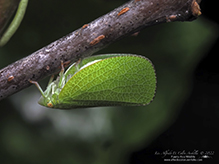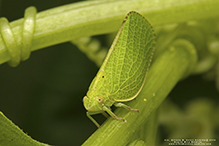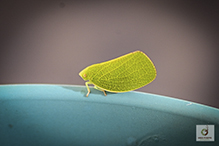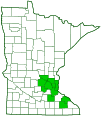green cone-headed planthopper
(Acanalonia conica)
Conservation • Description • Habitat • Ecology • Distribution • Taxonomy
Conservation Status |
|
|||||||
| IUCN Red List | not listed |
|||||||
| NatureServe | not listed |
|||||||
| Minnesota | not listed |
|||||||
Description |
||
A planthopper is an insect in the superfamily Fulgoroidea that resembles a leaf in its environment. It often hops like a grasshopper for transportation, but it usually walks slowly to avoid detection. There are more than 12,500 described planthopper species worldwide. Green cone-headed planthopper occurs in the United States east of the Great Plains and in Ontario and Quebec Canada. It was recently introduced into northern Italy. It is common and widespread throughout the eastern United States. In Minnesota it has been recorded just in the Metro Region and south to Rice and Wabasha Counties. Adults are yellowish-green and about ¼″ (6 mm) long. The body is flattened laterally. From above it appears wedge-shaped. The top of the head (vertex) is straight, flat, and horizontal. The upper part of the face (frons), corresponding to the forehead, is mostly keeled. When viewed from above the front of the head is pointed. When viewed from the side the face is straight, without a shelf-like step. The compound eyes are yellow or orangish-yellow. The antennae are attached on the sides of the head below the eyes. They are short, bristle-like, and three-segmented. The first segment is small and collar-like. There are two small black dots between the wing bases. The forewings are broadly oval and irregularly net-veined. They are held almost vertical when at rest. There is usually no stripe on the inner edge if the forewing. The leading (costal) margin is also net-veined—there are no parallel veins along the margin. Two anal veins meet beyond the middle of the wing to form a Y vein. The margin at the tip is green with brown, dash-like spots. The hindwings are fully developed. On the hind leg, the fourth segment (tibia) has spines at the tip only, no lateral spines. The last part of the leg (tarsus), corresponding to a foot, has three segments. On the hind leg, the second tarsal segment is minute with a rounded tip and a spine at each side. The nymph is green and hump-backed. |
||
Size |
||
Total length: ¼″ (6 mm) |
||
Similar Species |
||
Habitat |
||
|
||
Ecology |
||
Season |
||
|
||
Behavior |
||
It often hops, like a grasshopper, for transportation, but usually walks slowly to avoid detection. |
||
Life Cycle |
||
|
||
Nymph Food |
||
|
||
Adult Food |
||
It feeds on a wide variety of woody species and some herbaceous species. |
||
Distribution |
||||
|
Sources |
|||
| 8/9/2022 | ||||
Occurrence |
||||
Widespread and common |
||||
Taxonomy |
|||
Order |
Hemiptera (True bugs, Hoppers, Aphids, and Allies) |
||
Suborder |
Auchenorrhyncha (true hoppers) |
||
| Infraorder | Fulgoromorpha (planthoppers) | ||
Superfamily |
Fulgoroidea |
||
Family |
Acanaloniidae |
||
Subfamily |
Acanaloniinae |
||
| Tribe | Acanaloniini | ||
Genus |
Acanalonia | ||
Synonyms |
|||
|
|||
Common Names |
|||
green cone-headed planthopper |
|||
Glossary
Frons
The upper front part of an insect’s face, roughly corresponding to the forehead.
Tarsus
On insects, the last two to five subdivisions of the leg, attached to the tibia; the foot. On spiders, the last segment of the leg. Plural: tarsi.
Tibia
The fourth segment of an insect leg, after the femur and before the tarsus (foot). The fifth segment of a spider leg or palp. Plural: tibiae.
Vertex
The upper surface of an insect’s head.
Visitor Photos |
|||||
Share your photo of this insect. |
|||||
| This button not working for you? Simply email us at info@MinnesotaSeasons.com. Attach one or more photos and, if you like, a caption. |
|||||
Alfredo Colon |
|||||
 |
 |
||||
Mike Poeppe |
|||||
 |
|||||
MinnesotaSeasons.com Photos |
|||||
|
|||||

Slideshows |
||

Visitor Videos |
|||
Share your video of this insect. |
|||
| This button not working for you? Simply email us at info@MinnesotaSeasons.com. Attach a video, a YouTube link, or a cloud storage link. |
|||
Other Videos |
|||
| Cone-headed Planthoppers (Acanalonia conica) on Passion Flower Nature Documentaries |
|||
About
Jan 27, 2022 Cone-headed planthoppers (Acanalonia conica) on a passion flower vine (Passiflora incarnata) whose extrafloral nectaries are patrolled and defended by ants (Formica palidefulva). Filmed on August 9, 2014 at the Georgia State Botanical Garden in Athens, GA, USA. iNaturalist record of the observation: |
|||
| Cone-headed Planthopper (Acanalonia conica) Saltaplantas Bambolero VideotecaFaunaPR |
|||
About
Jan 2, 2019 Parece una hoja, pero es un hemíptero de amplia distribución en América. El color verde y la reticulada venación de sus alas, y su distintiva cabeza cónica, le permite camuflarse muy bien en el follaje. Permanece relativamente quieto, y aunque puede brincar, frecuenta desplazarse con un singular bamboleo. Se alimenta perforando las hojas de determinadas plantas para ingerir sus jugos. La gran variedad fenotípica de este género da la impresión de que es un grupo polifilético. Filmado en Trujillo Alto. Google Translate: It looks like a leaf, but it is a widely distributed hemiptera in America. The green color and the reticulated venation of its wings, and its distinctive conical head, allow it to camouflage itself very well in the foliage. It remains relatively still, and although it can jump, it often moves with a singular wobble. It feeds by piercing the leaves of certain plants to ingest their juices. The great phenotypic variety of this genus gives the impression that it is a polyphyletic group. Filmed in Trujillo Alto. |
|||
| Acanalonia conica scuola secondaria |
|||
About
Jul 5, 2022 |
|||


Created: 8/23/2020
Last Updated:



